The Spatial Correlation Network of China’s High-Quality Development and Its Driving Factors
Abstract
:1. Introduction
2. Study Methods and Data Sources
2.1. Entropy Weight Method
2.2. Modified Gravity Model
2.3. Social Network Analysis
- (1)
- Overall Network Structure Characteristics: The overall network structure can be evaluated using network density, network hierarchy, and network efficiency [31,32]. Network density measures the density of the spatial correlation networks of high-quality development. The higher the density, the greater the degree of correlation, implying stronger spatial correlation. Network hierarchy reflects the hierarchical structure of the spatial correlation network of high-quality development, with a higher hierarchy indicating greater interprovincial asymmetric accessibility. Network efficiency, on the other hand, characterizes the efficiency of connections between provinces in the spatial correlation network of high-quality development. A low network efficiency indicates a more stable network.The specific models are as follows:Network density:where, L is the actual association tree in a high-quality development spatial correlation network, and N is the number of nodes in the network. In this paper, N = 30.Network hierarchy:where, U represents the logarithm of the symmetric reachable point number in the spatial correlation network of high-quality development, and max(U) is the maximum logarithm of symmetrically reachable points.Network efficiency:where, K represents the number of redundant connections in the spatial correlation network of high-quality development, and max(K) is the maximum value of redundant connections.
- (2)
- Individual Network Structure Characteristics: Degree centrality, betweenness centrality, and closeness centrality are utilized to capture the characteristics of the individual network structure [33,34]. Degree centrality measures the extent to which a province occupies a central position in the spatial correlation network of high-quality development. A higher degree of centrality indicates a more central role for the province within the network. Betweenness centrality captures the importance of the province as a “bridge” within the spatial correlation network of high-quality development. A higher betweenness centrality indicates a more significant role in facilitating connections between other provinces. Closeness centrality reflects the extent to which a province’s correlation relationships are not dependent on other provinces in the spatial correlation network of high-quality development. A higher closeness centrality value indicates that the province occupies a central actor position within the network.The specific models are as follows:Degree centrality:where, ni represents the number of regions directly connected to area i in the spatial correlation network of high-quality development.Betweenness centrality:where, gik represents the number of connections between region j and region k, and gik(i) represents the number of connections between region j and k through region i. Therefore, bik(i) represents the possibility that region i is located at the connection between region j and region k.Closeness centrality:where, dig represents the sum of all connections from region i to region j.
2.4. Spatial Agglomeration Analysis
2.5. QAP Regression Analysis
2.6. Data Sources
3. Measurement of the Level of High-Quality Development
3.1. Construction of the Index System
3.2. Level Measure
4. Spatial Correlation Network
4.1. Formation Mechanism of Spatial Correlation for High-Quality Development
4.2. Overall Network Structure Characteristics
4.3. Individual Network Structure Characteristics
- Degree Centrality
- 2.
- Betweenness Centrality
- 3.
- Closeness Centrality
4.4. Spatial Agglomeration Characteristics
5. Analysis of Driving Factors
5.1. Specification of Variables
5.2. QAP Correlation Analysis
5.2.1. Internal Driving Factors
5.2.2. External Driving Factors
5.3. QAP Regression Analysis
5.3.1. Internal Driving Factors
5.3.2. External Driving Factors
6. Conclusions and Policy Recommendations
- ①
- During the study period, China’s overall high-quality development level maintained a steady growth trend, and the spatial correlation network became more dense. In terms of overall network characteristics, there was an increasing fluctuation in network density, while network hierarchy and network efficiency showed a decreasing trend. Interprovincial high-quality development also gradually strengthened.Looking at individual networks, there were significant differences in the centrality of each province. Shanghai, Beijing, and Jiangsu exhibited high centrality and exerted a strong influence in the spatial correlation network for high-quality development, thus, they can be considered central actors in the network. Alternatively, Inner Mongolia, Liaoning, and Xinjiang possess fewer direct connections with other provinces, rendering it difficult for them to exert control and dominate over other provinces. Consequently, these provinces hold the status of marginal actors within the spatial correlation network.Through block model analysis, it was found that there were notable spatial correlations and spillover effects among the spatially related plates of high-quality development. Section I, recognized as the main beneficiary sector, is concentrated mainly in the eastern and northern coastal regions. Section II, known as the broker sector, is primarily situated in the southern coastal areas. Section III, referred to as the bidirectional overflow sector, is mainly concentrated in the middle Yellow River and northeast areas. Finally, Section IV, known as the net overflow sector, is mainly concentrated in the middle Yangtze River, northwest, and southwest areas.
- ②
- After conducting the QAP method analysis, it is evident that the spatial correlation of high-quality development is significantly correlated with both internal and external drivers during the sample study period. In terms of internal drivers, the spatial correlation of “innovation”, “greenness”, “openness” and “sharing” were identified as the primary driving forces behind the spatial correlation of high-quality development, with “sharing” having the most significant influence. Regarding external factors, it was discovered that advancements in financial development, social consumption, and convenient transport significantly bolster the spatial correlation of high-quality development. Conversely, local protectionism and the effects of population agglomeration do not contribute to the improving of spatial correlation for high-quality development.
Author Contributions
Funding
Institutional Review Board Statement
Informed Consent Statement
Data Availability Statement
Acknowledgments
Conflicts of Interest
References
- Qu, Y.B.; Wang, S.L.; Tian, Y.Y.; Jiang, G.H.; Zhou, T.; Meng, L. Territorial spatial planning for regional high-quality development: An analytical framework for the identification, mediation and transmission of potential land utilization conflicts in the Yellow River Delta. Land Use Policy 2023, 125, 106462. [Google Scholar] [CrossRef]
- Chen, Y.; Yang, R.; Wong, C.W.Y.; Miao, X. Environmental performance of china’s economic system: Integrative perspective of efficiency and productivity. Technol. Econ. Dev. Econ. 2022, 28, 743–774. [Google Scholar] [CrossRef]
- Chen, L.; Huo, C. The Measurement and Influencing Factors of High-Quality Economic Development in China. Sustainability 2022, 14, 9293. [Google Scholar] [CrossRef]
- Martinez, M.; Mlachila, M. The Quality of the Recent High-Growth Episode in Sub-Saharan Africa. IMF Work. Pap. 2013, 13. [Google Scholar] [CrossRef]
- Mlachila, M.; Tapsoba, R.; Tapsoba, S.J.A. A quality of growth index for developing countries: A proposal. Soc. Indic. Res. 2017, 134, 675–710. [Google Scholar] [CrossRef]
- Huang, X.; Cai, B.; Li, Y. Evaluation Index System and Measurement of High-quality Development in China. Rev. Cercet. Interv. Soc. 2020, 68, 163–178. [Google Scholar] [CrossRef]
- Li, N.; Song, Y.; Xia, W.; Fu, S.-N. Regional Transportation Integration and High-Quality Economic Development, Coupling Coordination Analysis, in the Yangtze River Delta, China. Systems 2023, 11, 279. [Google Scholar] [CrossRef]
- Li, X.; Tan, Y.; Tian, K. The Impact of Environmental Regulation, Industrial Structure, and Interaction on the High-Quality Development Efficiency of the Yellow River Basin in China from the Perspective of the Threshold Effect. Int. J. Environ. Res. Public Health 2022, 19, 14670. [Google Scholar] [CrossRef]
- Hua, X.; Lv, H.; Jin, X. Research on High-Quality Development Efficiency and Total Factor Productivity of Regional Economies in China. Sustainability 2021, 13, 8287. [Google Scholar] [CrossRef]
- Hu, S.; Yang, H.; Cai, B.; Yang, C. Research on spatial economic structure for different economic sectors from a perspective of a complex network. Phys. A-Stat. Mech. Its Appl. 2013, 392, 3682–3697. [Google Scholar] [CrossRef]
- Li, D.; Wei, Y.D.; Wang, T. Spatial and temporal evolution of urban innovation network in China. Habitat Int. 2015, 49, 484–496. [Google Scholar] [CrossRef]
- Tian, X.; Wang, J. Research on Spatial Correlation in Regional Innovation Spillover in China Based on Patents. Sustainability 2018, 10, 3090. [Google Scholar] [CrossRef]
- Peng, B.; Wang, Y.; Wei, G. Energy eco-efficiency: Is there any spatial correlation between different regions? Energy Policy 2020, 140, 111404. [Google Scholar] [CrossRef]
- Dong, J.; Li, C. Structure characteristics and influencing factors of China’s carbon emission spatial correlation network: A study based on the dimension of urban agglomerations. Sci. Total Environ. 2022, 853, 158613. [Google Scholar] [CrossRef] [PubMed]
- Sun, Z.; Guan, H.; Zhao, A. Research on the Synergistic Effect of the Composite System for High-Quality Development of the Marine Economy in China. Systems 2023, 11, 282. [Google Scholar] [CrossRef]
- Yu, G.; He, D.; Lin, W.; Wu, Q.; Xiao, J.; Lei, X.; Xie, Z.; Wu, R. China’s Spatial Economic Network and Its Influencing Factors. Complexity 2020, 2020, 6352021. [Google Scholar] [CrossRef]
- Zhuang, H.; Lin, H.; Zhong, K. Spatial spillover effects and driving factors of regional green innovation efficiency in china from a network perspective. Front. Environ. Sci. 2022, 10, 997084. [Google Scholar] [CrossRef]
- Feng, Z.; Chen, Z.; Cai, H.; Yang, Z. Evolution and influencing factors of the green development spatial association network in the Guangdong-Hong Kong-Macao greater bay area. Technol. Econ. Dev. Econ. 2022, 28, 716–742. [Google Scholar] [CrossRef]
- Zhang, Y.; Wang, T.; Supriyadi, A.; Zhang, K.; Tang, Z. Evolution and Optimization of Urban Network Spatial Structure: A Case Study of Financial Enterprise Network in Yangtze River Delta, China. ISPRS Int. J. Geo-Inf. 2020, 9, 611. [Google Scholar] [CrossRef]
- Sun, T.; Ding, S.; Xu, X. An iterative stacked weighted auto-encoder. Soft Comput. 2021, 25, 4833–4843. [Google Scholar] [CrossRef]
- Yang, L.; Wang, J.; Yang, Y. Spatial evolution and growth mechanism of urban networks in western China: A multi-scale perspective. J. Geogr. Sci. 2022, 32, 517–536. [Google Scholar] [CrossRef]
- Fan, J.; Xiao, Z. Analysis of spatial association network of China’s green innovation. J. Clean. Prod. 2021, 299, 126815. [Google Scholar] [CrossRef]
- Kuik, O.; Branger, F.; Quirion, P. Competitive advantage in the renewable energy industry: Evidence from a gravity model. Renew. Energy 2019, 131, 472–481. [Google Scholar] [CrossRef]
- Liu, G.; Yang, Z.; Fath, B.D.; Shi, L.; Ulgiati, S. Time and space model of urban pollution migration: Economy-energy-environment nexus network. Appl. Energy 2017, 186, 96–114. [Google Scholar] [CrossRef]
- Wang, J.; Gao, X.; Jia, R.; Zhao, L. Evaluation Index System Construction of High-Quality Development of Chinese Real Enterprises Based on Factor Analysis and AHP. Discret. Dyn. Nat. Soc. 2022, 2022, 8733002. [Google Scholar] [CrossRef]
- Li, Y.; Li, Y.; Pan, A.; Pan, X.; Veglianti, E. The Network Structure Characteristics and Determinants of the Belt & Road Industrial Robot Trade. Emerg. Mark. Financ. Trade 2022, 58, 1491–1501. [Google Scholar] [CrossRef]
- Aplin, L.M.; Farine, D.R.; Morand-Ferron, J.; Cockburn, A.; Thornton, A.; Sheldon, B.C. Experimentally induced innovations lead to persistent culture via conformity in wild birds. Nature 2015, 518, 538–541. [Google Scholar] [CrossRef]
- Lv, K.; Feng, X.; Kelly, S.; Zhu, L.; Deng, M. A study on embodied carbon transfer at the provincial level of China from a social network perspective. J. Clean. Prod. 2019, 225, 1089–1104. [Google Scholar] [CrossRef]
- Sun, Q.; Tang, F.; Tang, Y. An economic tie network-structure analysis of urban agglomeration in the middle reaches of Changjiang River based on SNA. J. Geogr. Sci. 2015, 25, 739–755. [Google Scholar] [CrossRef]
- Lusher, D.; Johan, K.; Garry, R. Exponential Random Graph Models for Social Networks: Theory, Methods, and Applications; Cambridge University Press: London, UK, 2012. [Google Scholar]
- Krackhardt, D. Graph Theoretical Dimensions of Informal Organizations. Computational Organizational Theory; Lawrence Erlbaum Associates Inc.: Hillsdale, NJ, USA, 1994; pp. 89–111. [Google Scholar]
- Freeman, L.C.; Borgatti, S.P.; White, D.R. Centrality in valued graphs: A measure of betweenness based on network flow. Soc. Netw. 1991, 13, 141–154. [Google Scholar] [CrossRef]
- Costenbader, E.; Valente, T.W. The stability of centrality measures when networks are sampled. Soc. Netw. 2003, 25, 283–307. [Google Scholar] [CrossRef]
- Everett, M. Social network analysis. Textbook at Essex Summer School in SSDA; University of Essex: Essex, UK, 2002. [Google Scholar]
- Doreian, P.; Conti, N. Social context, spatial structure and social network structure. Soc. Netw. 2012, 34, 32–46. [Google Scholar] [CrossRef]
- Zhang, B.; Wang, Y. The Effect of Green Finance on Energy Sustainable Development: A Case Study in China. Emerg. Mark. Finance Trade 2019, 57, 3435–3454. [Google Scholar] [CrossRef]
- Lin, P.-P.; Li, D.-F.; Jiang, B.-Q.; Yu, G.-F.; Wei, A.-P. Evaluating the comprehensive impacts of tourism in hainan by intergrating input-output model with mcdm methods. Technol. Econ. Dev. Econ. 2020, 26, 989–1029. [Google Scholar] [CrossRef]
- Zhang, F.; Tan, H.; Zhao, P.; Gao, L.; Ma, D.; Xiao, Y. What was the spatiotemporal evolution characteristics of high-quality development in China? A case study of the Yangtze River economic belt based on the ICGOS-SBM model. Ecol. Indic. 2022, 145, 109593. [Google Scholar] [CrossRef]
- Yu, G.; Wan, Y.; Jiang, C. Complex network analysis on provincial innovation development in China. Appl. Math. Comput. 2023, 455, 128103. [Google Scholar] [CrossRef]
- Mai, Q.; Bai, M.; Li, L. Study on the Dynamic Evolution and Regional Differences of the Level of High-Quality Economic and Social Development in China. Sustainability 2023, 15, 382. [Google Scholar] [CrossRef]
- Zhao, W.; Xu, C. Measuring the Dual Openness of Provincial Economies in China. China Soft Sci. 2005, 8, 81–90. [Google Scholar]
- Wang, D.; Hou, Y.; Li, X.; Huang, Y.; Wang, Y. Spatio-temporal Analysis of China’s Livelihood Development: Evidence from a Functional Index Model. Model. Appl. Spat. Anal. 2022, 15, 1493–1523. [Google Scholar] [CrossRef]
- Zhu, H.; Chen, S.; Irfan, M.; Hu, M.; Hu, J. Exploring the role of the belt and road initiative in promoting sustainable and inclusive development. Sustain. Dev. 2023, 1–12. [Google Scholar] [CrossRef]
- Wang, X.; Dong, F.; Pan, Y.; Liu, Y. Transport infrastructure, high-quality development and industrial pollution: Fresh evidence from China. Int. J. Environ. Res. Public Health 2022, 19, 9494. [Google Scholar] [CrossRef] [PubMed]
- Su, Y.; Yu, Y.-Q. Spatial association effect of regional pollution control. J. Clean. Prod. 2019, 213, 540–552. [Google Scholar] [CrossRef]
- Guo, Y.; Cao, L.; Song, Y.; Wang, Y.; Li, Y. Understanding the formation of City-HSR network: A case study of Yangtze River Delta, China. Transp. Policy 2022, 116, 315–326. [Google Scholar] [CrossRef]
- Young, A. The razor’s edge: Distortions and incremental reform in the People’s Republic of China. Q. J. Econ. 2000, 115, 1091–1135. [Google Scholar] [CrossRef]
- Huang, J.; Jin, H.; Ding, X.; Zhang, A. A Study on the Spatial Correlation Effects of Digital Economy Development in China from a Non-Linear Perspective. Systems 2023, 11, 63. [Google Scholar] [CrossRef]
- Kim, Y.K.; Setterfield, M.; Mei, Y. A theory of aggregate consumption. Eur. J. Econ. Econ. Policies Interv. 2014, 11, 31–49. [Google Scholar] [CrossRef]
- Ehrlich, I.; Lui, F. The problem of population and growth: A review of the literature from Malthus to contemporary models of endogenous population and endogenous growth. J. Econ. Dyn. Control. 1997, 21, 205–242. [Google Scholar] [CrossRef]
- Liu, T.-Y.; Su, C.-W. Is transportation improving urbanization in China? Socio-Econ. Plan. Sci. 2021, 77, 101034. [Google Scholar] [CrossRef]
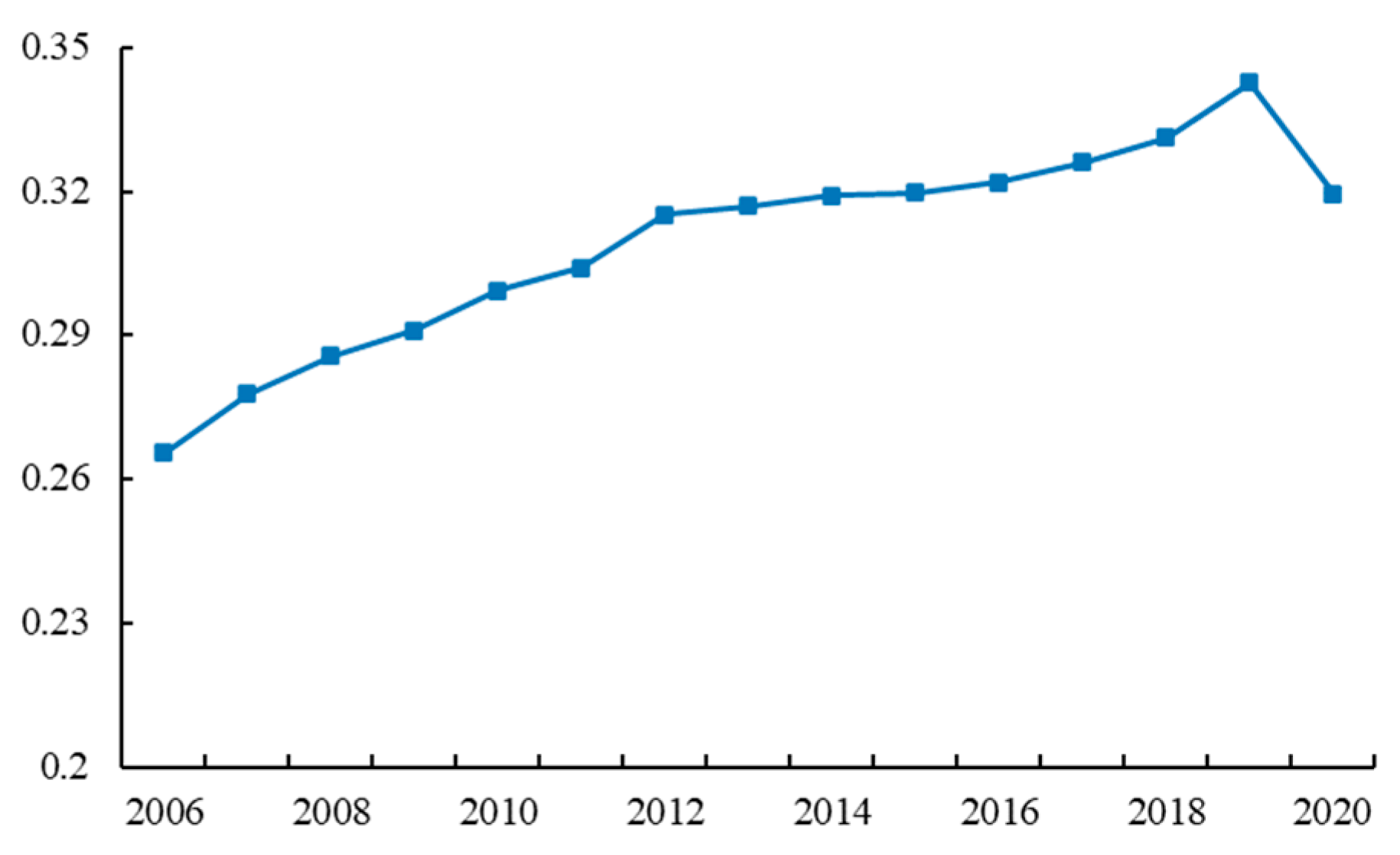
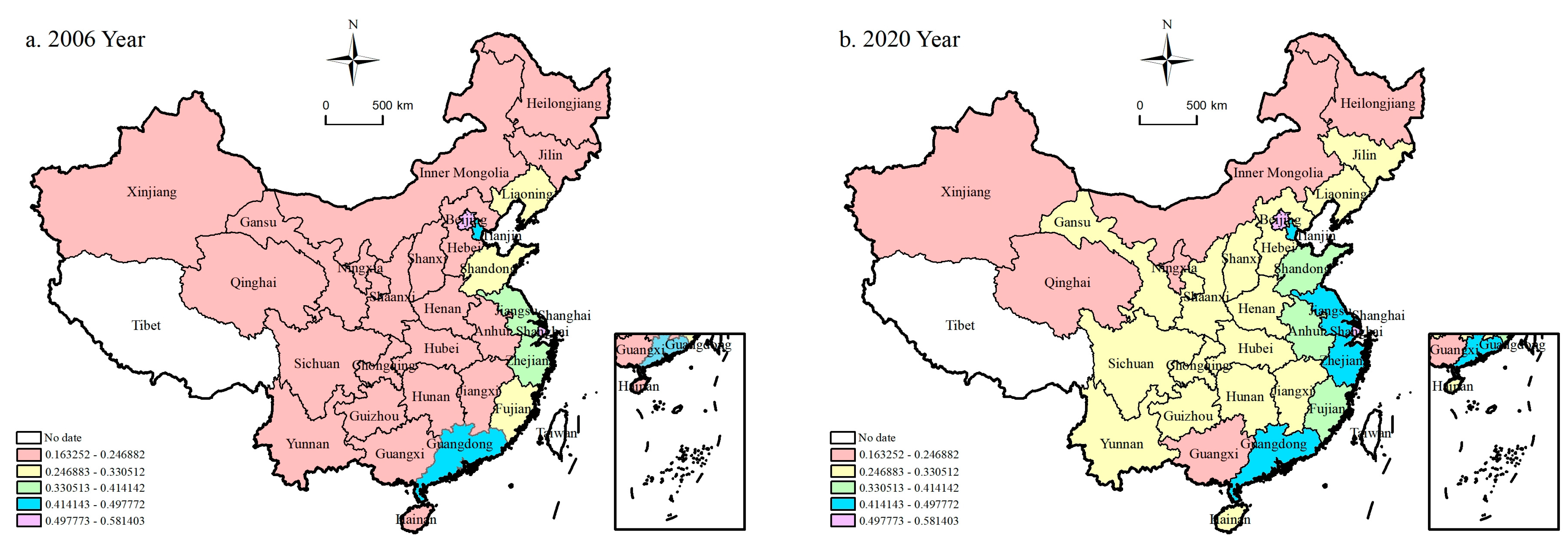


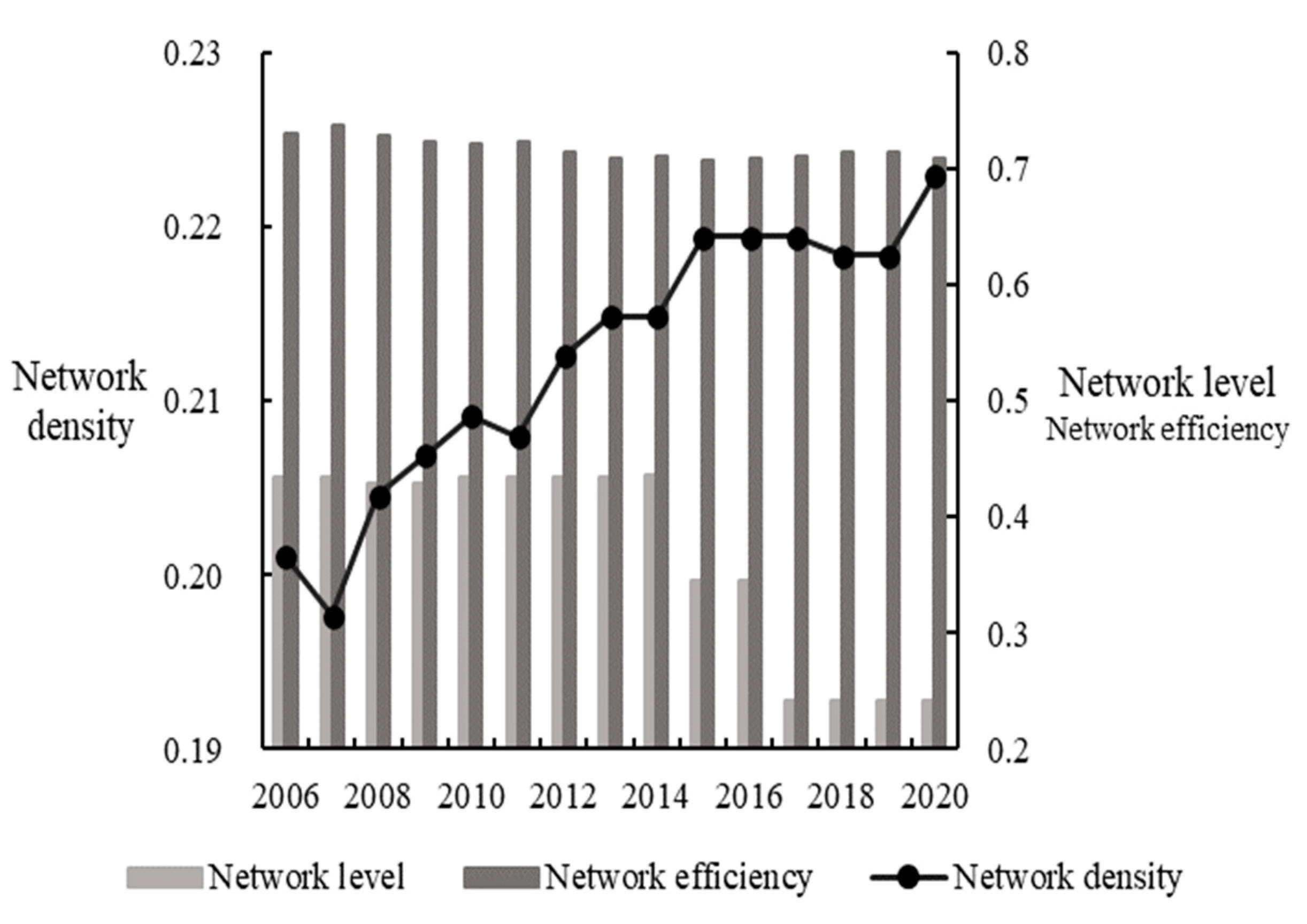
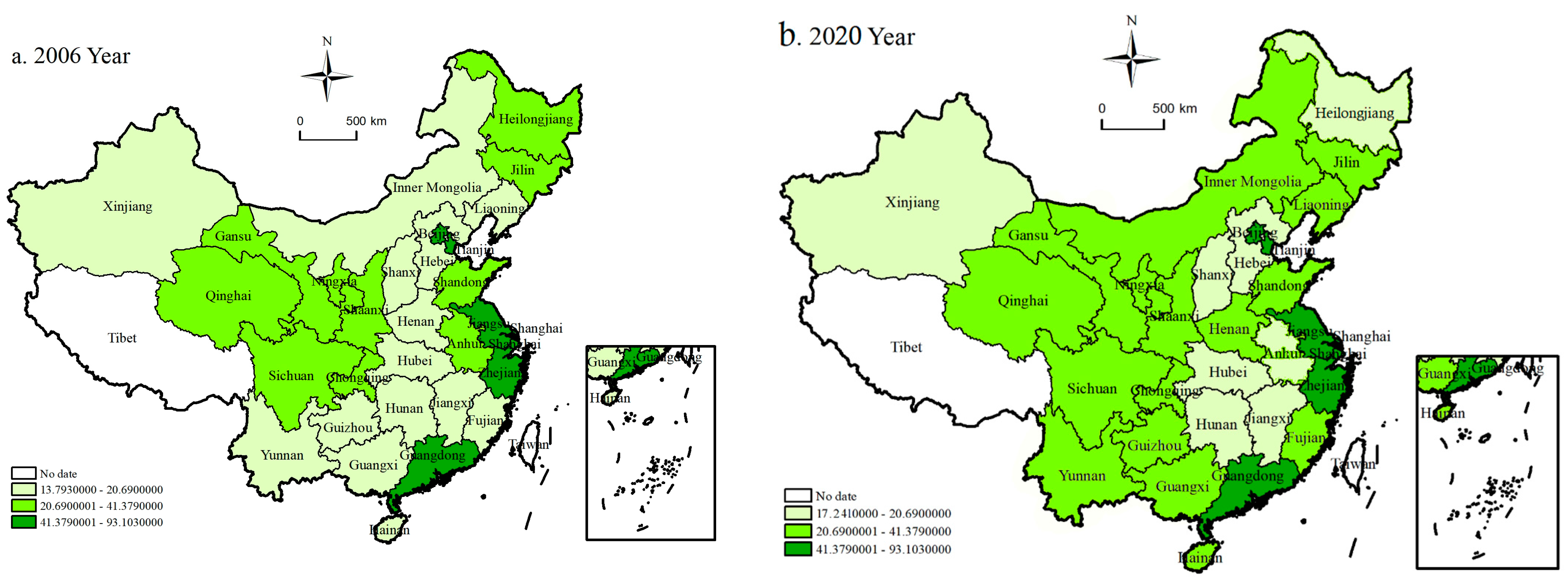
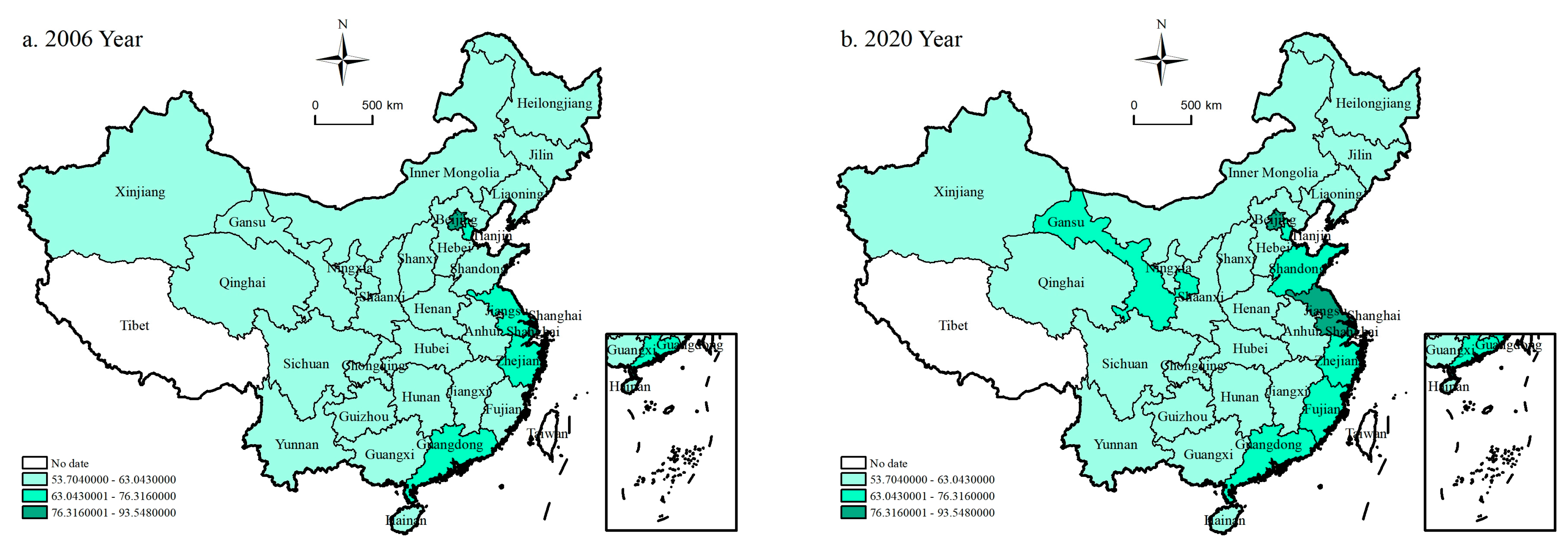
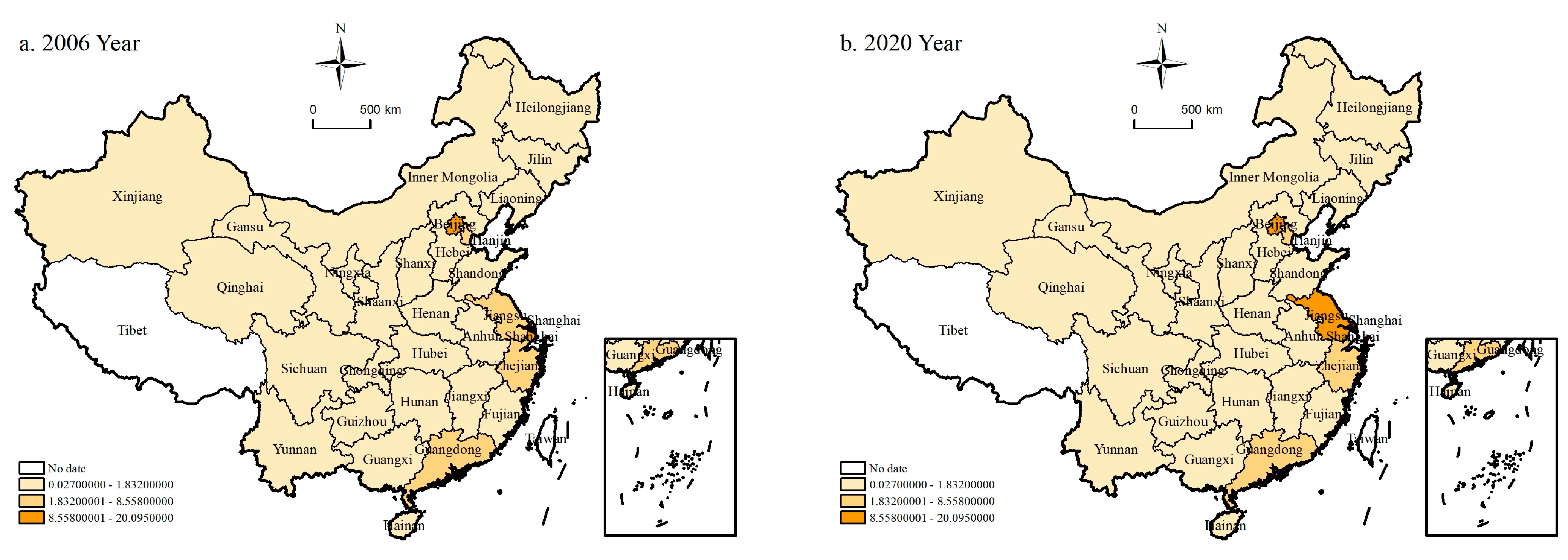
| Dimension | First Level | Second Level | Indicators |
|---|---|---|---|
| Innovation | Innovation input | R&D personnel input level (+) | R&D personnel FTE per year-end resident population |
| R&D funding intensity (+) | R&D expenditure as a percentage of GDP | ||
| Innovation output | Invention patents (+) | Granted invention patents per year-end resident population | |
| Technology market transaction volume (+) | Technology market turnover as a percentage of GDP | ||
| Innovation environment | Technological funding (+) | S and T expenditure as a percentage of local general public budget expenditure | |
| High-tech industry (+) | The proportion of high-tech industry enterprises in a region to the overall number of such enterprises nationwide | ||
| Coordination | Industrial structure | Industrial structure rationalization (+) | Index of industrial structure rationalization |
| Industrial structure upgrading (+) | Index of industrial structure upgrading | ||
| Regional structure | Urban-rural coordination (+) | Rate of urbanization | |
| Inter-provincial coordination (+) | Per capita GDP of a region as a percentage of the national per capita GDP | ||
| Economic structure | Stable employment (−) | Registered urban unemployment rate | |
| Economic fluctuations (−) | Economic volatility | ||
| Greenness | Utilization of resources | Electricity consumption (−) | Electricity consumption as a percentage of GDP |
| Water consumption (−) | Total water consumption as a percentage of GDP | ||
| Energy consumption (−) | Total energy consumption as a percentage of GDP | ||
| Environmental governance | Domestic waste disposal (+) | Rate of harmless treatment of domestic waste | |
| Sewage treatment (+) | Rate of sewage treatment | ||
| Waste utilization (+) | Overall utilization rate of general industrial solid waste | ||
| Openness | Internal Openness | Labor mobility (+) | Interregional labor mobility 1 |
| Division of labor in a region (+) | Interregional division of labor 2 | ||
| Passenger density (+) | Passenger turnover per unit length of transportation routes | ||
| Freight density (+) | Freight turnover per unit length of transportation routes | ||
| External Openness | Foreign trade dependence (+) | Total import and export volume as a percentage of GDP | |
| Foreign investment dependence (+) | Total foreign investment as a percentage of GDP | ||
| International tourism (+) | Per capita international tourism revenue | ||
| Sharing | Quality of life | Living standards (+) | GDP per capita |
| Transportation (+) | Number of public transport vehicles per 10,000 people | ||
| Healthcare (+) | Number of doctors per 10,000 people | ||
| Green spaces (+) | Green park space per capita | ||
| Education (+) | Number of compulsory education teachers per 10,000 people | ||
| Cultural engagement (+) | Public library collections per capita | ||
| Social Security | Basic endowment insurance (+) | Coverage rate of basic endowment insurance | |
| Unemployment insurance (+) | Coverage rate of unemployment insurance | ||
| Basic medical insurance (+) | Coverage rate of basic medical insurance |
| Section | Number | In-Degree | Out-Degree | ||
|---|---|---|---|---|---|
| Intra-Plate | Off-Plate | Intra-Plate | Off-Plate | ||
| Section I | 5 | 6 | 100 | 6 | 21 |
| Section II | 3 | 0 | 21 | 0 | 25 |
| Section III | 8 | 11 | 18 | 11 | 34 |
| Section IV | 14 | 2 | 28 | 2 | 87 |
| Variable | Measurement Method |
|---|---|
| Protection | The reciprocal of (the Hoover localization coefficient multiplied by the Krugman index) |
| Finance | Ratio of financial institution deposits and loans to regional GDP |
| Consumption | Total retail sales of consumer goods |
| Traffic | Road mileage per unit of land area |
| Agglomeration | Resident population per unit of land area |
| HQD | Innovation | Coordination | Greenness | Openness | Sharing | |
|---|---|---|---|---|---|---|
| HQD | 1.000 *** | 0.995 *** | 0.999 *** | 0.995 *** | 0.999 *** | 0.999 *** |
| Innovation | 0.995 *** | 1.000 *** | 0.993 *** | 0.997 *** | 0.992 *** | 0.993 *** |
| Coordination | 0.999 *** | 0.993 *** | 1.000 *** | 0.993 *** | 1.000 *** | 0.999 *** |
| Greenness | 0.995 *** | 0.997 *** | 0.993 *** | 1.000 *** | 0.993 *** | 0.994 *** |
| Openness | 0.999 *** | 0.992 *** | 1.000 *** | 0.993 *** | 1.000 *** | 0.999 *** |
| Sharing | 0.999 *** | 0.993 *** | 0.999 *** | 0.994 *** | 0.999 *** | 1.000 *** |
| HQD | Protection | Finance | Consumption | Traffic | Agglomeration | |
|---|---|---|---|---|---|---|
| HQD | 1.000 *** | 0.966 *** | 0.955 *** | 0.955 *** | 0.912 *** | 0.949 *** |
| Protection | 0.966 *** | 1.000 *** | 0.978 *** | 0.989 *** | 0.949 *** | 0.967 *** |
| Finance | 0.955 *** | 0.978 *** | 1.000 *** | 0.980 *** | 0.951 *** | 0.975 *** |
| Consumption | 0.955 *** | 0.989 *** | 0.980 *** | 1.000 *** | 0.943 *** | 0.972 *** |
| Traffic | 0.912 *** | 0.949 *** | 0.951 *** | 0.943 *** | 1.000 *** | 0.932 *** |
| Agglomeration | 0.949 *** | 0.967 *** | 0.975 *** | 0.972 *** | 0.932 *** | 1.000 *** |
| Variable | Un-Stdized Coefficient | Stdized Coefficient | Significance |
|---|---|---|---|
| Innovation | 0.141 | 0.142 | 0.000 |
| Coordination | 0.019 | 0.019 | 0.185 |
| Green | 0.060 | 0.061 | 0.003 |
| Openness | 0.155 | 0.154 | 0.004 |
| Sharing | 0.626 | 0.625 | 0.000 |
| Intercept term | −0.001 | 0.000 | - |
| Variable | Un-Stdized Coefficient | Stdized Coefficient | Significance |
|---|---|---|---|
| Protection | −0.254 | −0.266 | 0.000 |
| Finance | 0.876 | 0.887 | 0.000 |
| Consumption | 0.188 | 0.196 | 0.001 |
| Traffic | 0.263 | 0.274 | 0.000 |
| Agglomeration | −0.116 | −0.123 | 0.001 |
| Intercept term | 0.078 | 0.000 | - |
Disclaimer/Publisher’s Note: The statements, opinions and data contained in all publications are solely those of the individual author(s) and contributor(s) and not of MDPI and/or the editor(s). MDPI and/or the editor(s) disclaim responsibility for any injury to people or property resulting from any ideas, methods, instructions or products referred to in the content. |
© 2023 by the authors. Licensee MDPI, Basel, Switzerland. This article is an open access article distributed under the terms and conditions of the Creative Commons Attribution (CC BY) license (https://creativecommons.org/licenses/by/4.0/).
Share and Cite
Chen, M.; Li, Q.; Zhang, B.; Xie, L.; Liu, J.; Geng, Y.; Liu, Z. The Spatial Correlation Network of China’s High-Quality Development and Its Driving Factors. Sustainability 2023, 15, 15738. https://doi.org/10.3390/su152215738
Chen M, Li Q, Zhang B, Xie L, Liu J, Geng Y, Liu Z. The Spatial Correlation Network of China’s High-Quality Development and Its Driving Factors. Sustainability. 2023; 15(22):15738. https://doi.org/10.3390/su152215738
Chicago/Turabian StyleChen, Minghua, Qian Li, Bianxiu Zhang, Linxiao Xie, Jianxu Liu, You Geng, and Zhirui Liu. 2023. "The Spatial Correlation Network of China’s High-Quality Development and Its Driving Factors" Sustainability 15, no. 22: 15738. https://doi.org/10.3390/su152215738
APA StyleChen, M., Li, Q., Zhang, B., Xie, L., Liu, J., Geng, Y., & Liu, Z. (2023). The Spatial Correlation Network of China’s High-Quality Development and Its Driving Factors. Sustainability, 15(22), 15738. https://doi.org/10.3390/su152215738





